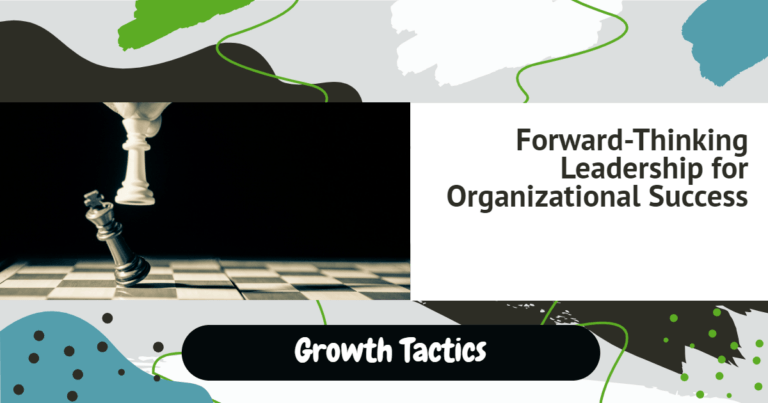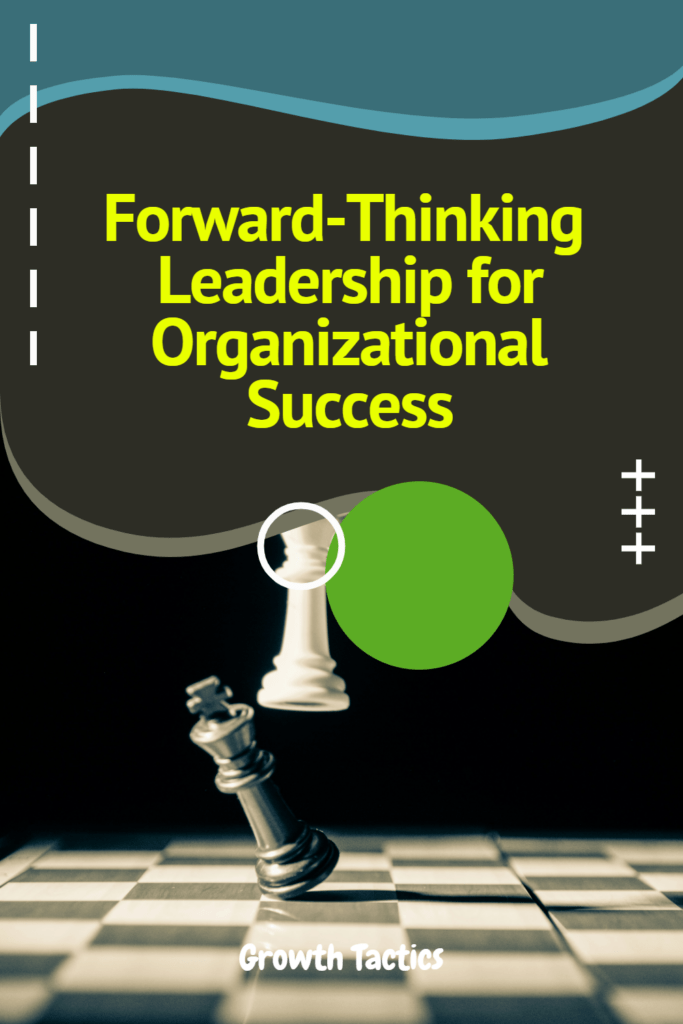Forward-thinking leadership is a style of leadership focused on driving innovation, embracing change, and strategically preparing an organization for long-term success. At its core, forward-thinking leadership is about having a future-focused mindset and being able to anticipate trends, challenges, and changes that may impact the organization.
Forward-thinking leaders have an expansive perspective and are able to think beyond day-to-day operations. They are visionaries who are focused on the future and what is possible. These leaders recognize that the world is constantly evolving and that organizations must evolve as well in order to remain competitive and successful.
Forward-thinking leaders have certain key qualities and values that enable their future-focused approach:
- They are insightful and have strong critical thinking skills which allow them to think strategically and make decisions that will drive innovation.
- They are open-minded and embrace new ideas, approaches, and perspectives. Not afraid to question the status quo.
- They are comfortable with change, uncertainty, and taking calculated risks. They view change as necessary for progress.
- Focus on adding value, empowering people, and enabling the organization to adapt and grow.
- They have excellent communication skills and are able to clearly articulate vision in a compelling way.
- They are willing to delegate responsibility and trust people to perform. Invest in developing talent.
- They think long-term, considering how decisions today will impact future success.
In essence, forward-thinking leaders have the vision, mindset and capabilities to guide an organization successfully into the future. They turn insight into innovation and drive progress through strategic, future-focused leadership.
Jump To Section
Why Forward-Thinking Leadership Matters

Forward-thinking leadership provides immense value and benefits for organizations. This type of leadership is essential for driving innovation, evolution, and strategic growth.
Forward-thinking leaders focus on the future rather than being stuck in the status quo. They are able to anticipate trends and changes in the market, as well as visualize how to take the organization to the next level. With an expansive mindset, forward-thinking leaders can comprehend what’s on the horizon and make decisions that will propel the organization forward.
Organizations need forward-thinking leaders who can pave new paths, take measured risks, and guide the company towards a visionary future. This type of leadership is key for discovering new opportunities, optimizing processes, and executing strategies to elevate the organization. Forward-thinking leadership brings an organization to the forefront, making it more competitive, productive, and successful.
Rather than focusing solely on immediate issues, forward-thinking leaders also consider the organization’s long-term goals. They are strategic and future-oriented in their thinking. With strong foresight, they can make decisions today that will drive sustainable growth for years to come. This prevents organizations from becoming stagnant or being left behind by competitors.
Overall, forward-thinking leadership provides immense benefits for organizational success. It is a driving force for innovation, evolution, and strategic growth. Forward-thinking leaders can visualize the future, guide change, and transform organizations to reach their full potential.
Developing a Forward-Thinking Mindset
Forward-thinking leaders embrace innovation and change. They are open to new ideas and willing to evolve. A forward-thinking mindset means focusing on where you want the organization to be in the future, not just where it is today.
To develop a forward-thinking mindset as a leader, you must be receptive to new ways of doing things. Don’t be afraid to challenge the status quo and consider how processes, products or services could be improved. Ask “what if” questions and encourage your team to brainstorm creative solutions. Look for inspiration outside your industry. Learn from companies in different fields who are innovating in interesting ways.
Forward-thinking leaders also make decisions with the future in mind. They anticipate challenges on the horizon and make strategic choices intended to propel the organization forward. This means thinking long-term instead of focusing solely on immediate issues. While day-to-day operations are important, forward-thinking leaders balance short-term and long-term thinking.
To strengthen a forward-thinking mindset, stay focused on the future and where you want to go. Set visionary goals for the organization and align decision-making to reach those goals. Seek new ideas and be willing to evolve. With this mindset, you can lead your team forward with purpose.
Making Decisions with a Forward-Thinking Approach

Forward-thinking leaders make decisions with the future in mind. They weigh both short and long term impacts, considering how their choices will affect the organization and its stakeholders not just today but years down the road.
When making decisions, forward-thinking leaders seek diverse perspectives from team members at all levels of the organization. They understand the value of seeing issues from different angles and getting input from people with varied backgrounds and experiences. This inclusive approach leads to better informed decisions.
Forward-thinking leaders ask probing questions to fully explore the problem at hand. They gather as much data and insight as possible before deciding on a course of action. Once a decision is made, they clearly communicate the rationale to provide transparency into the process.
By taking the time to research decisions thoroughly and view them through multiple lenses, forward-thinking leaders make choices that drive innovation and position their organizations for sustainable success. Their ability to anticipate future needs gives them a strategic advantage in an ever-evolving business landscape.
Driving Innovation
Forward-thinking leaders understand that innovation is vital for organizational success and longevity. They encourage and reward creativity within their teams, allowing for experimentation and intelligent risk-taking.
Forward-thinkers know that innovation does not happen in a vacuum – it requires an environment that supports new ideas. As a leader, think about how you can foster innovation daily. Empower your team to think creatively without fear of failure. Innovation means trying new approaches and learning from mistakes.
To drive innovation, leaders must:
- Allow time for brainstorming and creative thinking
- Let team members run small experiments and pilot projects
- Reward innovative ideas and solutions, even if unsuccessful
- Accept some risk-taking as part of the process
- Ask lots of questions to spur new thinking
- Challenge assumptions and the status quo
By promoting a spirit of innovation, leaders enable their organizations to adapt and stay ahead of the curve. They create a workplace where everyone feels motivated to ideate, invent, and iterate. Driving innovation also keeps team members engaged, as they actively participate in envisioning the future.
Forward-thinking leaders don’t just wait for innovation to happen – they make it a strategic priority. They put mechanisms in place to capture new ideas and remove obstacles to experimentation. With a culture of innovation, an organization can continuously evolve and improve.
Embracing Change

Forward-thinking leaders understand that change is inevitable. While many resist or fear change, forward-thinkers embrace it. They see change as an opportunity for growth rather than a threat.
To help their teams welcome change, forward-thinking leaders:
- Clearly communicate the reasons for change and the benefits it will bring. They paint a vision of the future that gets people excited.
- Involve team members early in the change process to get buy-in. When people feel heard, they’re more likely to support change.
- Provide training and resources to smooth the transition. This empowers people with the skills and knowledge to adapt.
- Acknowledge concerns and anxieties. Forward-thinkers listen empathetically rather than dismissing emotions.
- Celebrate small wins and milestones. This maintains momentum during an uncertain time.
- Lead by example in adopting changes themselves. They model the attitude and behaviors expected of others.
- Check-in regularly on progress and make course corrections as needed. Change management is an iterative process.
With the right strategies, forward-thinking leaders turn change from a threat into an opportunity. They inspire teams to embrace change as a chance to innovate, improve, and stay competitive.
Developing People
Forward-thinking leaders focus on developing people by coaching, mentoring, and creating growth opportunities. They understand that empowering others is key to driving innovation and success.
As a coach, a forward-thinking leader provides guidance, shares insights, and helps team members strengthen skills. They ask thoughtful questions to promote learning and growth. Mentoring goes a step further to build capabilities over the long term. Forward-thinking leaders take a genuine interest in mentees’ career journeys.
Forward-thinkers create an environment where everyone feels empowered to evolve and adapt. They provide tools to help people innovate and meet objectives. Development opportunities like training, job rotation, and special projects allow for new skills. Challenging assignments outside comfort zones spur growth.
Forward-thinking leaders elevate people. They propel everyone around them to bring more value. This means unlocking potential, building confidence, and expanding capabilities. With an empowered team equipped with future-ready skills, organizations can move forward and thrive.
Communicating Vision

Forward-thinking leaders understand the power of vision. They are able to paint a compelling picture of the future that motivates and inspires teams. Communicating vision is a key part of driving an organization forward.
Forward-thinking leaders align teams around a shared vision of the future. This vision provides purpose and direction, energizing people and helping coordinate efforts. Leaders communicate the vision in a way that is clear, relatable, and actionable. They connect the vision to the values and goals of team members.
When communicating vision, forward-thinking leaders:
- Share an inspirational vision of the future that feels achievable and exciting
- Connect the vision to meaningful goals and a higher purpose
- Ensure the vision is easy to understand and repeat
- Reinforce the vision regularly through words and actions
- Invite input to co-create aspects of the vision
- Align day-to-day tasks and decisions with the vision
- Use vivid language and imagery to make the vision memorable
- Convey passion and optimism when describing the future
- Encourage teams to think big and see opportunities
With a compelling vision, forward-thinking leaders motivate teams, unify cross-functional efforts, and drive progress. The vision acts as a strategic tool to propel the organization in an innovative direction.
Taking Strategic Risks
Forward-thinking leaders understand that calculated risks are necessary for growth and innovation. While reckless risks can be detrimental, smart risks allow organizations to evolve and stay competitive.
Forward-thinkers take risks strategically – they assess potential downsides but keep the big picture in mind. They don’t make rash decisions, but they aren’t afraid to think outside the box and try new approaches.
Leaders must empower their teams to take risks as well. This starts by creating an environment where people feel safe to experiment, make mistakes, and take initiative. Make it clear that incremental progress and effort are valued, even if ideas don’t always pan out.
Forward-thinking leaders see risk management as a process, not an obstacle. They put structures in place to mitigate risks, but don’t let fear of failure limit progress. With the right vision and preparation, risks turn into opportunities for growth.
Taking strategic risks requires confidence and courage. But forward-thinkers understand that playing it safe can be the most dangerous option of all. They know that managing risk today is necessary to build success tomorrow.
Measuring Success
Forward-thinking leaders understand that success extends beyond short-term gains and requires tracking metrics aligned with long-term vision. Rather than focusing solely on quarterly returns or year-over-year growth, forward-thinkers measure strategic progress by how their organization innovates, evolves, and positions itself for the future.
Key metrics for a forward-thinking leader include:
- Employee engagement and development
- Customer satisfaction and loyalty
- New products, services, and business models
- Process and technology improvements
- Movement into new markets or growth areas
They don’t just check boxes and hit targets handed to them. Forward-thinkers define success on their own terms by how well they pave the way for future opportunity and sustainable growth.
This long-view approach requires patience but pays dividends over time as forward-thinking leaders transform their organization and empower people to think beyond temporary gains. Measuring strategic success enables iteration and gives permission to experiment, fail, learn, and try again.
Forward-thinking leaders are driven by their vision for the future, not just immediate results. By focusing on leading indicators and tracking evolutionary progress, they position their organization for enduring achievement.
Wrapping Up
In today’s fast-paced and ever-changing business environment, forward-thinking leadership is crucial for organizational success. A forward-thinking leader is someone who is constantly thinking about new ways to innovate, move the company forward, and add value to the workplace. By being a strategic and insightful coach, an executive can guide their team to adapt and thrive in a constantly evolving market. It is clear that forward-thinking leadership is essential for organizations to stay ahead of the competition and achieve long-term success.


